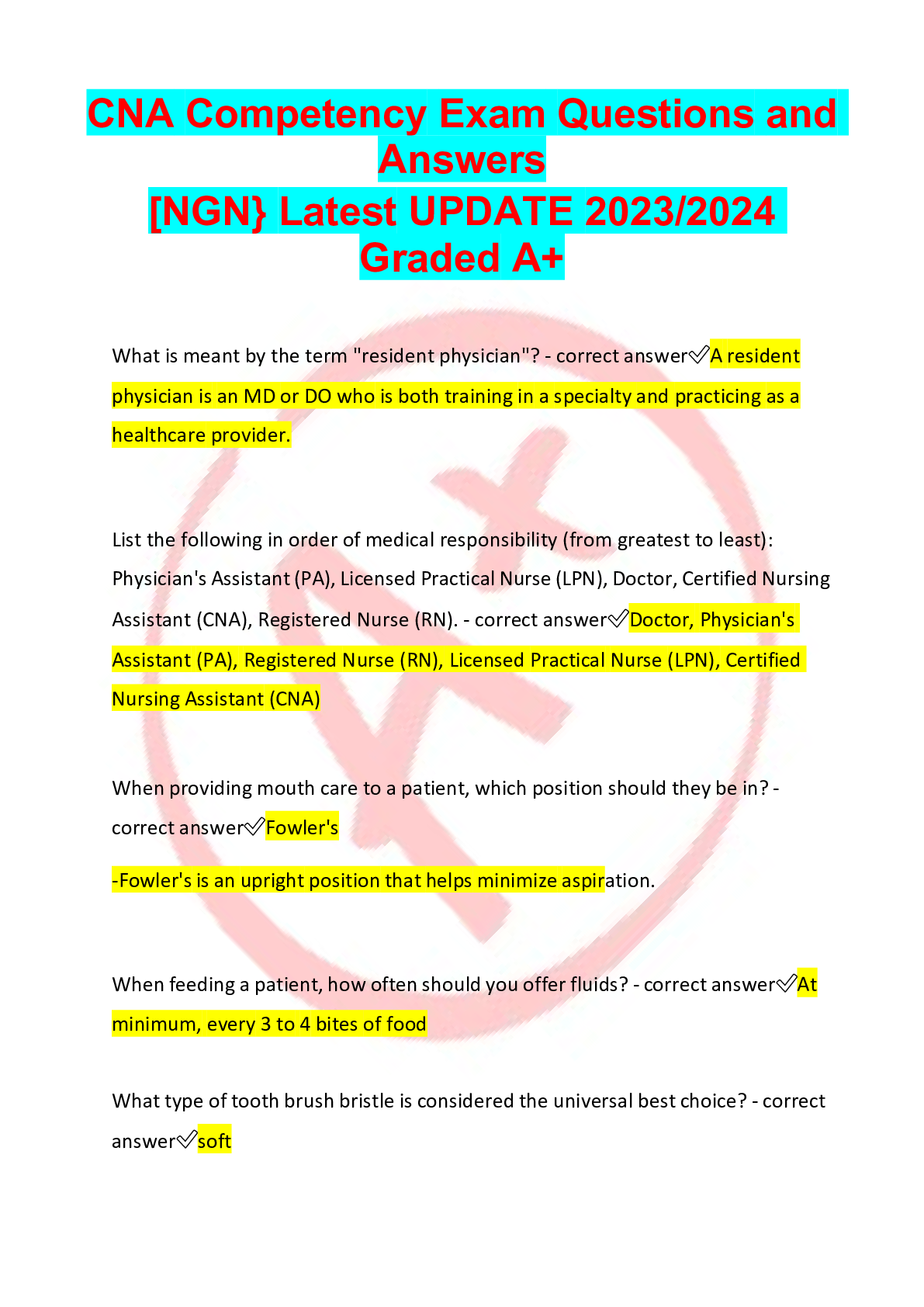
Rasmussen College - MCB 2289 Microbiology Final Exam|Module 11/ Already Graded A
$ 13

CNA Competency Exam Questions and Answers [NGN} Latest UPDATE 2023/2024 Graded A+
Surgery > QUESTIONS & ANSWERS > Surgery Week Quiz Series - Part 10 [GRADED A+] (All)
Surgery week 10 quiz Q # 1 of 39- 1 Points USMLE Step 2 CK Board Preparation 1. A sexually active woman with multiple partners presents with a 2-day history of red swollen left knee. On examinatio ... n there is tenderness and decreased range of motion. There is no history of trauma, no affectation of other joints, and she has inflamed right achillis tendon. The most likely diagnosis is: A. Septic arthritis B. Gouty arthritis C. Rheumatoid arthritis D. Systemic Lupus erythematosus E. Pseudo gout 2. A 75-year-old Caucasian woman arrives in the Emergency Department after a fall down the front steps of her building. She complains of intense pain in her left hip. When she tried to stand, she was unable to put weight on her left leg. The patient had been previously healthy and had no significant past medical history. Lab tests were performed including TSH, urine studies, blood chemistries, CBC, and WBC. These were all within normal limits. A radiograph was performed and a fracture of the femoral neck was clearly visible. Addition tests were performed including a bone density test. The patient was found to have a T-score of -2.8. The most likely cause of this patient’s fracture is A. Hypothyroidism B. Osteoporosis C. Multiple myeloma D. Osteogenesis imperfecta E. Osteopenia 3. A 35-year-old man presents with knee pain that makes him unable to move his knee. The pain began 3 days ago and has increased markedly; it was preceded by a flu-like illness 1 week ago, along with a skin rash on his thigh that has red margins and a pale center. The patient states that the symptoms started 2 weeks after he came back from a hiking trip last month. He denies any urinary or GI symptoms. He has no other significant past history. What is the most likely diagnosis? A. Gonococcal arthritis B. Rheumatoid arthritis C. Lyme disease D. Gouty arthritis E. Reiter disease 4. A 20-year-old man presents after taking a fall during a skiing trip 2 days ago. The chief complaint is pain to the right thumb. During the examination, you note gross laxity in the first metacarpophalangeal joint when moving the right thumb into abduction. An X-ray reveals no fracture. What structure is injured? A. Radial collateral ligament of the thumb? B. Ulnar collateral ligament of the thumb C. Flexor tendons of the thumb D. Extensor tendons of the thumb E. Median nerve damage 5. A 50-year-old woman presents with a painful red foot. She does not have a significant past medical history. 2 nights ago, she went to an office party. She ate and drank throughout the evening and later spent a great deal of time on the dance floor. Throughout the night, she felt fine and continued to enjoy herself. Over the next 2 days, she began to have increased pain and swelling in her right foot. The pain became so severe that she could not put her foot flat on the ground to walk. On examination, it is noted that her largest toe on her right is red, swollen, and painful to touch. She cannot bend the toe or bear her full weight on that foot. Her blood pressure is 122/84 mm Hg, and pulse is 80/min; respiration is 14/min, and temperature is 38.2° C. A CBC is done and is within normal range. An analysis of her synovial fluid shows an elevated white blood cell count and crystals are birefringent, with strong negative elongation when viewed under polarized light. What is the most likely diagnosis? A. Gout B. Stress fracture C. Pseudogout D. Cellulitis E. Septic arthritis 6. A 56-year-old man wakes up in the morning to find that he has a swollen, red, painful big toe on his left foot. 2 days earlier, he had been on a cruise to the Bahamas, and he spent much of the time eating and drinking. He normally has 1 glass of wine with dinner on the weekends, but while on the cruise, his alcohol consumption increased substantially. He also did a great deal of walking in an attempt to make up for his excesses. He goes in to his physician's office, and tests are run. An X-ray shows no acute fracture, and his vital signs are within normal limits. Blood work shows an increase in uric acid, but it is otherwise normal. He begins treatment and feels better within 24 hours. What statement is true? A. Attacks are polyarticular in nature B. Smaller, lower-extremity joints are usually involved first C. Diet has no effect on this disease D. Whites are affected more frequently than blacks E. It occurs frequently in men under the age of 25 [Show More]
Last updated: 2 years ago
Preview 1 out of 12 pages
![Preview image of Surgery Week Quiz Series - Part 10 [GRADED A+] document](https://browseimages.nyc3.digitaloceanspaces.com/paper-images/2023/May/08/zYyq8wl72023-05-08-03-386458ed5846f08.png)
Buy this document to get the full access instantly
Instant Download Access after purchase
Buy NowInstant download
We Accept:


Surgery week 10 quiz Q # 1 of 39- 1 Points USMLE Step 2 CK Board Preparation 1. A sexually active woman with multiple partners presents with a 2-day history of red swollen left knee. On examinatio...
By geeks4geeks 2 years ago
$35
10
Can't find what you want? Try our AI powered Search
Connected school, study & course
About the document
Uploaded On
May 08, 2023
Number of pages
12
Written in
All
This document has been written for:
Uploaded
May 08, 2023
Downloads
0
Views
100
Scholarfriends.com Online Platform by Browsegrades Inc. 651N South Broad St, Middletown DE. United States.
We're available through e-mail, Twitter, Facebook, and live chat.
FAQ
Questions? Leave a message!
Copyright © Scholarfriends · High quality services·